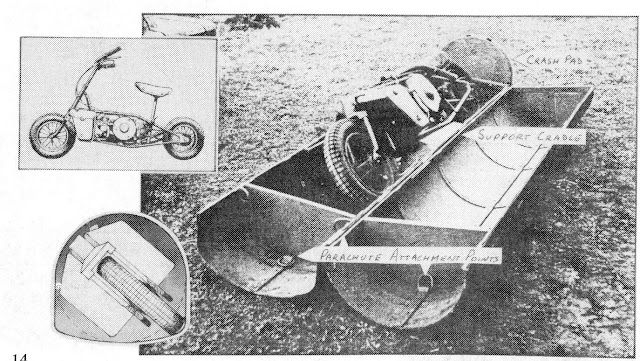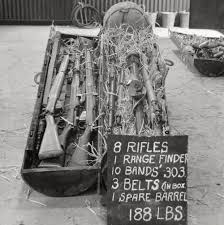British Airborne CLE supply canisters
Coming up to D-Day this year I have started to revamp and add some bits to my 20mm British Airborne units, gliders and paratroops. As an ex Para, I have a lot of these chaps, I have already built two regiments of paras (120 odd figures) and a battalion of Glider borne troops for Arnhem, plus I have the Canadians and Poles not painted yet sitting in the unpainted pile, but my goal this year is really to add the fluff to the collection and mini dioramas to my British Parachute division collection.
First up will be some Central Landing Establishment or C.L.E supply canisters (postwar called container light equipment) plus a few larger wicker panniers along with the coloured parachutes for my supplies. With the advent of the British Parachute units supply was seen to be an issue so they simply copied the german idea of supply canisters, this is primarily for my reference but happy to share. I will also do an American supply article to coincide with my US airborne revamp.
C.L.E container
The delivery of the containers was in a variety of ways. The C-47 Douglas Dakotas were fitted with 6 attachment hard-points for canisters to be dropped with the parachutists, often missed by modellers who build a C-47 with parachutists deploying under canopy. Any bombers or fighters could use the hard bomb points to deliver supply canisters also.
C-47 Dakota with CLE containers attached
Loading CLE containers onto hardpoints
parachute inspection before loading
note the red cross on the container
Lysander resupply type H container
Basket drop Arnhem
supply drop Stirling Bombers
The C.L.E. Containers were all very similar, basically a hinged tube, one end had a hollow fitting for the parachute, and the other end had a percussion crash dome attached. The metal percussion head was a primitive shock absorber with rubber inserts; with a rounded end it was designed to roll with the fall direction or even collapse upon impact with the ground if there was no wind (common because of the British parachute design), this reduced the amount of force on the container’s contents. The percussion head also could house a flashing light for night drops, it was also detachable so it could be replaced, and the container could be reused.
The C.L.E. Mark I Container was made from a metal framework faced with plywood; constructed in two halves that were then hinged together to form a hemispherical cylinder with four carry handles. Internally it had structural ribs and could be divided up into one large, or alternately two or three compartments with plywood dividers, allowing either smaller containers or smaller items to be packed separately. It was closed with two external latches. The Mark I was 6 feet 2 ½ inches in length, with a diameter of 1 foot 2 inches; it weighed 103 ½ pounds empty, with a maximum loaded weight of 350 pounds. Typically 12 rifles, or eight rifles and either a Bren or vickers MG with 1000 rounds of 303 cartridges. I have seen them RAF blue-grey, white and OD green.


The C.L.E. Mark I.T. Container made entirely of metal, it was 6 feet 2 ½ inches, it however it was a flat-bottomed cylinder. It was heavier ,135 pounds, but had the same maximum loaded weight of 350 pounds. Like the Mark I, it closed with two external latches. More commonly used for ammunition, Piat and mortar ammunition, petrol in specially designed round tins, and the welbike. After World War II, the Mark I.T. was referenced as the Mk. 1 (T) and was used up until the 1960s, with the last operational use in the 1956 Suez crisis. I have seen them painted OD Green and Raf blue-grey, white and black for resistance drops (with a shovel attached for burying)
packing small items and felt padding
The C.L.E. Mark III Container was 5 feet 6 ½ inches, completely cylindrical, with a diameter of 1 foot 2 inches. The Mark III was made of either all-metal or metal-framed plywood construction. The Mark III weighed 113 ½ pounds empty; the original maximum loaded weight was 350 pounds, but after extensive use the maximum weight was revised to 400 pounds. The Mark III had a twin internal locking mechanism; a rectangular cutout at the parachute end of the container gave access to the locking handle. It also had four lamps in the cone. By 1943, the Mark III was intended to replace the earlier containers, unless a specific load required the greater length. Post-war manuals reference the Mark III as the Mk. 3. After World War II it was used up until the 1960s, with the last operational use in the 1956 Suez crisis.
I have seen them painted Green and RAF Blue-grey and white.
centre of gravity check, really important to prevent canister oscillation
The C.L.E Mark III Type C Container was 5 feet 1 inches and exclusively used by the SAS, it was the same as the C.L.E mark III however, three external latches, it was painted black and had no cone, but rubber dampening pad only. The CLE mark III weighed 350lBs loaded, with a 205lb payload. The parachute deployment also differed it had a spring ejected auxiliary parachute that deployed the main chute, rather than a static line deployment, so it could be dropped under 400 feet.
A rare survivor in the resistance museum in Brittany.
CLE Mark III type C SAS rubber tip vs round metal
The Type E Container was rectangular in shape with a hinged lid, and was designed specifically for dropping the Number 18 wireless/telegraphy set. The sets were packed in felt pads and rubber absorbers. The 1943 manual does not list the size of the Type E, it does give the weight as 89 pounds empty, or 190 pounds when loaded with the No. 18 W/T set; the 1960 manual does not reference the Type E. Only seen these in OD green.
The Type F Container was also rectangular, but longer than the Type E; it was 5 feet 8 ½ inches long, and 1 foot 2 inches tall by 1 foot 2 inches wide. The Type F could carry several different wireless/telegraphy sets, specifically the No. 11, 19, 21 or 22 sets. the sets were packed in felt pads and rubber absorbers. The container weighed 92 pounds empty; the loaded weight varied depending on the type of W/T set carried, but the maximum weight was 340 pounds. Only seen these OD green.
Type F container
Type H container designed for the for SAS, SOE and resistance, based on the CLE mark III. The type H container was much lighter than the other types, as the casing was not reinforced because of the cell nature of the container and the rubber bumper nose cone, a gross weight of 330 pounds (149 kg) loaded with a 235lb (106.5 kg) payload.
The container was held together with a rods that threaded through the body, as each shell separated, the cell sections could easily be carried by one man by its carry handle or two cells could be connected with a webbing carry strap and slung over the body. The cell components were lettered for easy identification of the contents (see markings below), and easily passed out to the different resistance sections in a matter of moments at the reception area. The original H 1942 model was 5ft 6 inches, but as the war progressed they could be adapted to any length of sections. Only the parachute and the rubber nose cone had to be buried on site with a spade strapped to the outside to aid in its burial. The parachute deployment was the same as the CLE mk III and had a spring ejected auxiliary parachute that deployed the main chute, rather than a static line deployment, so it could be dropped under 400 feet.
The English and Australian army were still using the H type containers in the 1990s when I served in airborne and special operations.
Baskets
Another item developed for dropping supplies was the wicker pannier, which was essentially a very large woven wicker basket and a plywood base. Rectangular in shape L 36.2 inches x W 21.6 inches x H 15.7 inches, they were only be dropped from C-47 that had been adapted for their use and were on transport rollers in the aircraft due to weight. They were in two halves, the top was slightly larger than the bottom so it could fit over it and had four braided rope handles. The two halves were not attached; there were no latches or hinges. Instead, the two halves were lashed together with green webbing straps. This gave the advantage that the size of the load did not have to be precise; the pannier could be expanded as needed. The wicker pannier had a maximum loaded weight of 500 pounds.
Typically, two panniers were bundled together; the dispatchers commonly referred to it as the “daisy chain” method, and naturally allowed for the panniers to be dispatched in half the time. One pannier was stacked on top of the other, and they were attached with lightweight cotton ties. Each pannier had its own parachute, but with different lengths of static line; this would cause them to open at different times, breaking the ties and separating the two panniers for landing. Alternatively they could be grouped together in groups of two, four or six with two parachutes Type R Mk1. this required four dispatches to get them out of the plane fully loaded.
c-47 despatch rollers
despatch exercise 19th April 1944
basket contents
Parachutes
The standard cargo parachute could be with made of silk, rayon or cotton blend, with heavy weight cotton thread in natural colour, and was standardised in 1942.
Type R Mk1 parachute - made from Rayon for light loads
GQ Irvin type X -the most common for canisters cotton blend.
Weight of delivery Up to 40lbs - 12 Foot Canopy
Weight of delivery 41 - 80 lbs - 16 Foot Canopy
Weight of delivery 81 - 120 lbs - 20 Foot Canopy
Weight of delivery 121 - 160 lbs - 24 Foot Canopy
Weight of delivery 161- 200 lbs - 28 Foot Canopy
Heavy equipment parachute 42F - 42 foot canopy for multiple baskets, and heavy items.
Parachute colours
The cargo parachutes were made originally in OD green in a variety of colours so that supply drops could be colour-coded. Different types of supplies, such as ammunition, rations, and medical equipment, could be designated by the colour of parachute and marked on the canister in a variety of ways; There was not a set system, and the colour-coding did vary for each operation.
DDAY
Red =Ammunition and ordnance
Yellow = medical supplies
Light Blue = Food
White = general supplies
Green = Signals
Arnhem
Red =Ammunition and ordnance
Yellow = signals
Light Blue = Fuel
White = medical
Green = Rations
Operation Varsity
Black = SOE/Resistance drops
Markings
The C.L.E containers carried a number of markings, from colour-code the tips of canisters and actual painted or sticker markings. More research required here!
motor cycle - motor cycle
C5 - Explosives
Medical - White red cross
SAS markings
SAS canisters were divided into sections each section of the canister was marked on the outside.
H1 explosives and accessories
H2 machine guns and ammunition
H3 various armaments
H4 incendiary equipment
H5 sabotage equipment
Manufactures of containers
15mm
Flames of War/Frontline
28mm
1st Corps make some lovely kit
Warlord games,
good painting refence from the 1/35th Black Dog selection
I will be scratch building mine and making a mold for casting in resin as I need about 40 of them. the next article will have my attempts!
cheers
Matt’s


























































